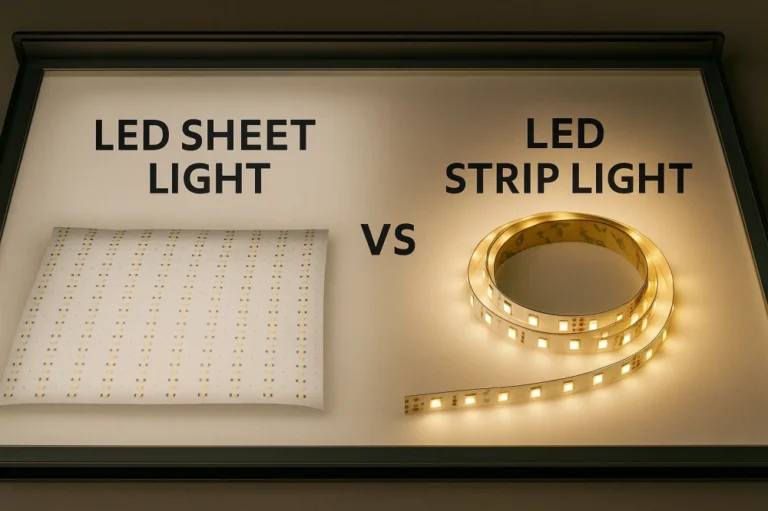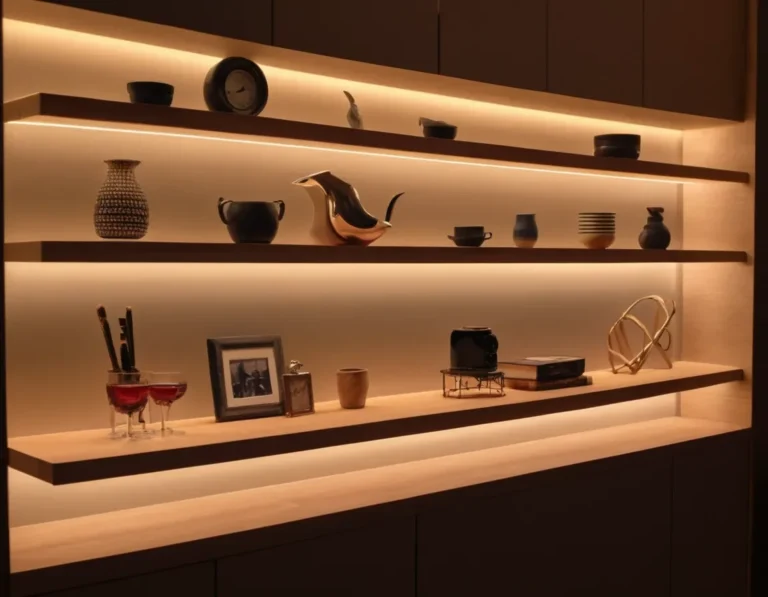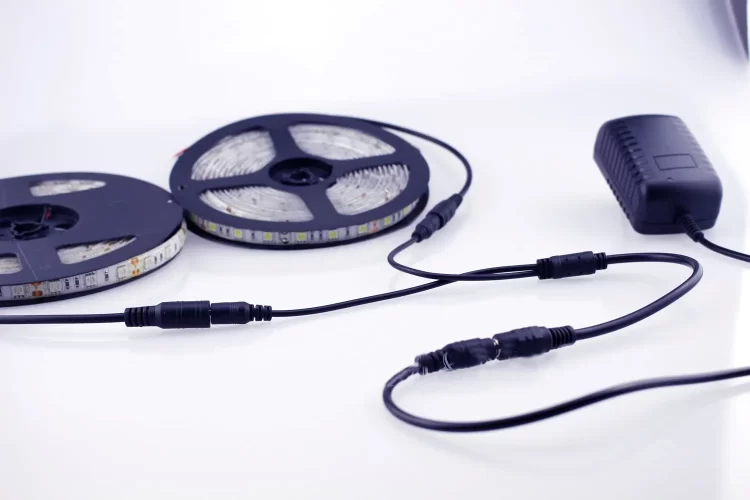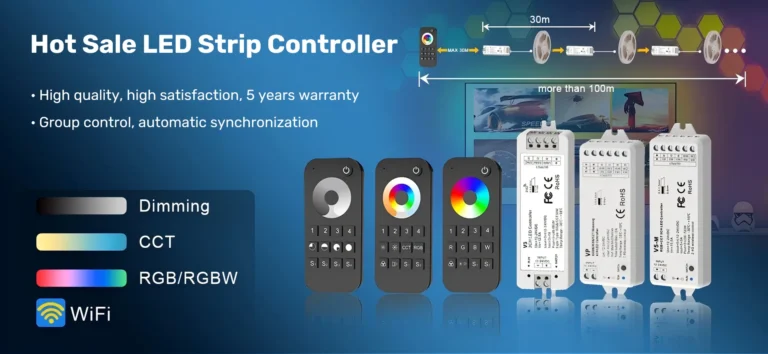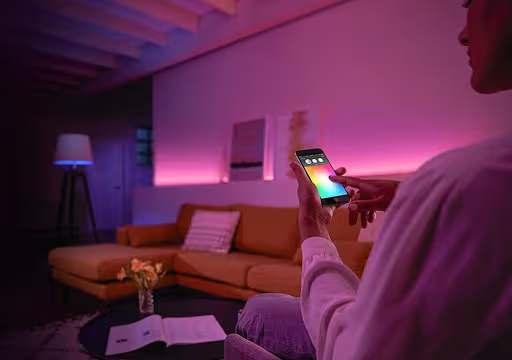Taśmy świetlne LED występują w różnych szerokościach, długościach i typach chipów LED, dzięki czemu są wszechstronne zarówno do zastosowań w oświetleniu mieszkaniowym, jak i komercyjnym. Jeśli chodzi o projekty oświetleniowe, wybór odpowiedniej szerokości taśmy świetlnej LED może być prawdziwym bólem głowy. Czy kiedykolwiek czułeś się przytłoczony zadaniem wyboru odpowiedniego rozmiaru taśmy świetlnej LED? Przyjrzyjmy się bliżej różnym opcjom szerokości, aby znaleźć idealną taśmę świetlną do swoich potrzeb oświetleniowych.
Paski świetlne LED występują w szerokiej gamie rozmiarów lub szerokości. Paski świetlne LED jednorzędowe mają zazwyczaj szerokość od 3 milimetrów do 15 milimetrów. Natomiast paski świetlne LED wielorzędowe mogą osiągać szerokość do 120 milimetrów. Użycie odpowiedniej szerokości paska świetlnego LED ma kluczowe znaczenie dla zapewnienia prawidłowego rozpraszania ciepła, elastycznej instalacji i innych czynników. Ponadto rozmiar chipów LED lub SMD jest kolejnym kluczowym czynnikiem wpływającym na szerokość pasków świetlnych LED.
Zrozumienie, jak każda szerokość paska LED wpływa na instalację i wydajność, jest kluczowe dla dokonania właściwego wyboru. Zanurzmy się głębiej w szczegóły!
Jaka jest szerokość paska świetlnego LED?
Szerokość Taśma świetlna LED odnosi się do jej fizycznej szerokości, konkretnie szerokości PCB (płytki drukowanej). Struktura paska świetlnego LED składa się z wielu diod LED ułożonych w regularny wzór na elastycznej płytce drukowanej (PCB). Dlatego szerokość paska świetlnego LED odnosi się zasadniczo do szerokości PCB, zwykle mierzonej w milimetrach (mm), wskazując wymiary materiału bazowego paska.
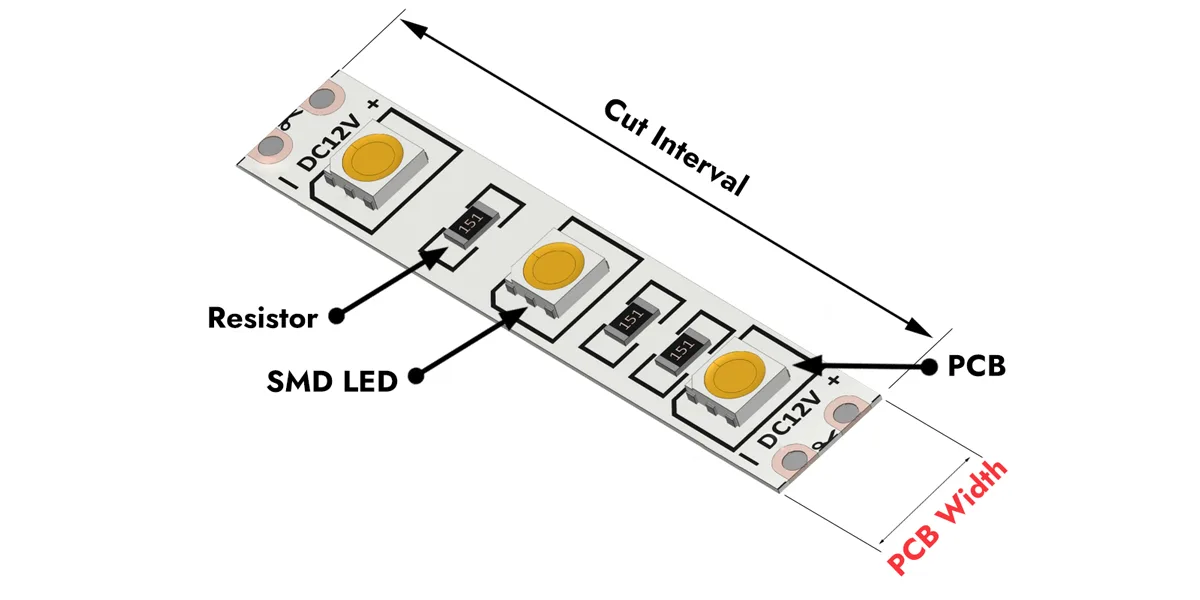
Wybierając i instalując paski świetlne LED do różnych projektów, szerokość paska jest ważnym czynnikiem. Szersze paski zazwyczaj mieszczą więcej diod LED, zapewniając jaśniejsze oświetlenie i lepsze odprowadzanie ciepła, podczas gdy węższe paski mogą być bardziej odpowiednie do instalacji z ograniczoną przestrzenią lub określonymi wymaganiami projektowymi.
Warto zauważyć, że szerokości pasków LED są różne. Na przykład, paski LED z jednym rzędem mają tylko jeden rząd chipów LED na całej długości, a ich szerokość waha się zazwyczaj od 1 mm do 15 mm. Z drugiej strony, paski LED z wieloma rzędami mają wiele rzędów chipów LED na całej płytce drukowanej. Dzięki temu są szersze niż paski LED z jednym rzędem, a ich szerokość sięga nawet 120 mm. Te paski LED mogą być dwurzędowe, trzyrzędowe, czterorzędowe, pięciorzędowe lub więcej.
Oczywiście wszystkie szerokości i liczbę rzędów diod LED można dostosować w zależności od producenta i planowanego zastosowania.
Dlaczego warto brać pod uwagę szerokość pasków świetlnych LED?
Szerokość pasków świetlnych LED jest krytycznym czynnikiem. Wybór odpowiedniej szerokości nie jest tylko kwestią estetyczną; ma również znaczący wpływ na jasność, natężenie oświetlenia, rozpraszanie ciepła, fizyczne zajęcie przestrzeni i elastyczność instalacji. Przyjrzyjmy się konkretnym powodom.
1. Jasność i oświetlenie:Szerokość paska świetlnego LED wpływa na jego jasność i ogólne natężenie oświetlenia. Szersze paski zazwyczaj mieszczą więcej diod LED, co skutkuje większą mocą światła, ale zużywają też więcej energii. Jeśli potrzebujesz jasnego oświetlenia, szersze paski mogą być bardziej odpowiednie. Z kolei węższe paski mogą wytwarzać łagodniejsze lub bardziej skupione światło.
2. Odprowadzanie ciepła: Paski świetlne LED generują ciepło podczas pracy. Przenoszenie ciepła generowanego przez diody LED do płytki drukowanej PCB i rozpraszanie go w otaczającym środowisku ma kluczowe znaczenie dla utrzymania niskiej temperatury paska świetlnego. W takim przypadku szersze paski świetlne LED mogą działać jako radiatory, pochłaniając i rozpraszając ciepło generowane przez diody LED. W porównaniu do węższych płytek drukowanych PCB, szersze płytki drukowane PCB są bardziej wydajne.
3. Projektowanie przestrzeni i estetyka: Paski świetlne LED są powszechnie stosowane do oświetlenia dekoracyjnego lub akcentującego. Szerokość paska świetlnego LED wpływa na wygląd wizualny całej przestrzeni i na to, jak dobrze integruje się z ogólnym projektem. Na przykład szersze paski świetlne mogą być bardziej odpowiednie do tworzenia odważnych, przyciągających wzrok efektów, podczas gdy węższe paski świetlne mogą tworzyć bardziej minimalistyczny lub stonowany wygląd.
4. Elastyczność instalacji: Jeśli przestrzeń instalacyjna jest bardzo wąska, instalacja szerszych pasków świetlnych LED może być trudna. Dlatego też ważne jest sprawdzenie szerokości pasków świetlnych LED, aby upewnić się, że pasują do przestrzeni instalacyjnej. Ponadto węższe paski są bardziej odpowiednie do narożników lub krawędzi, ponieważ można je łatwo wygiąć.
5. Zgodność akcesoriów:Szerokość pasków świetlnych LED ma kluczowe znaczenie dla zapewnienia kompatybilności z uchwytami montażowymi, Złącza LED, I inne akcesoriaAkcesoria te są zazwyczaj zaprojektowane tak, aby pasowały do konkretnych szerokości pasów świetlnych, dlatego wybór odpowiedniej szerokości zapewnia dobrą łączność i łatwą instalację.
6. Zgodność z kanałami aluminiowymi LED:Podczas dodawania kanały aluminiowe lub silikonowych dyfuzorów do pasków świetlnych LED, szerokość paska świetlnego jest krytycznym czynnikiem. Dodanie kanałów paska LED może zapewnić miękkie, równomierne światło, ale jeśli szerokość paska nie jest idealna, mogą pojawić się problemy z instalacją. W takich przypadkach należy wziąć pod uwagę zgodność między wewnętrzną średnicą kanału a szerokością paska LED. Na przykład paska LED o szerokości 10 mm nie można zainstalować w 5-milimetrowym aluminiowym kanale lub silikonowym dyfuzorze. Aby uzyskać więcej informacji na temat aluminiowych profili LED, przeczytaj „Profil aluminiowy do oświetlenia taśmowego LED.”
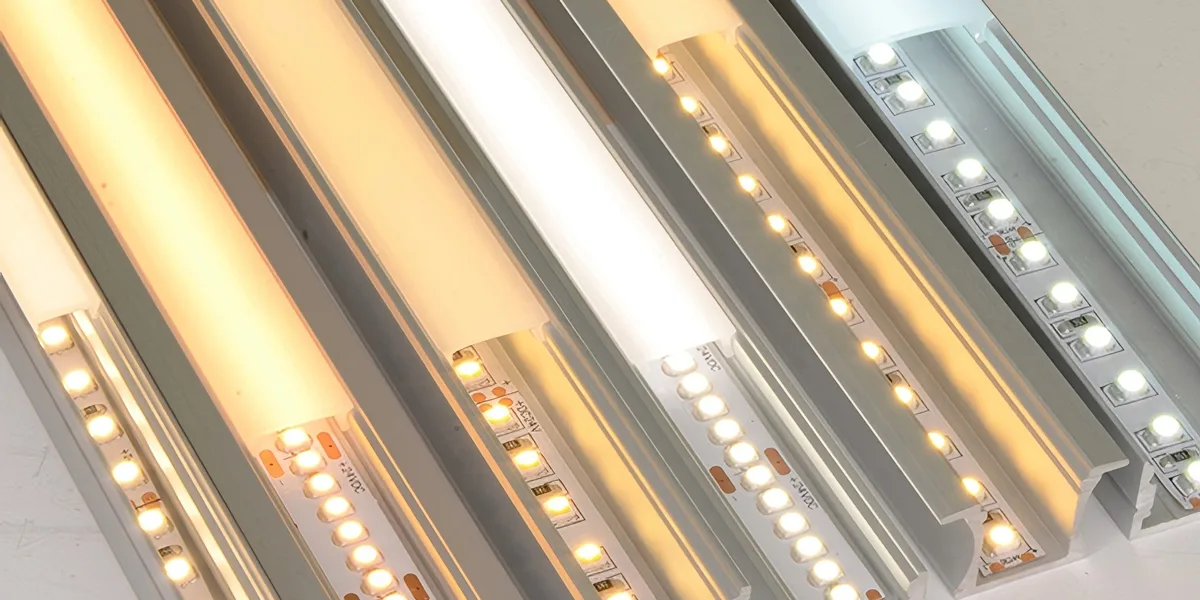
Jakie są standardowe szerokości taśm świetlnych LED?
Najpopularniejsze standardowe szerokości pasków świetlnych LED to 8 mm, 10 mm i 12 mm. Są to również trzy najszerzej stosowane szerokości. Szerokość pasków świetlnych LED różni się w zależności od marki, a także zależy od rodzaju paska świetlnego LED i rozmiaru chipów LED.
Taśmy świetlne LED 8mm: 8 mm paski świetlne LED są idealne do montażu w wąskich, niepozornych miejscach, spełniając rosnące zapotrzebowanie na oświetlenie akcentujące, oświetlenie pod szafkami lub oświetlenie mebli. Tak wąska szerokość może zaspokoić potrzebę subtelnego oświetlenia bez zajmowania zbyt dużej przestrzeni. Ta szerokość umożliwia nieskończone kreatywne zastosowania, takie jak dopasowanie do wnętrza szafek lub wzdłuż schodów, gdzie przestrzeń oświetleniowa jest ograniczona. Niska widoczność paska świetlnego wzmacnia efekt oświetlenia bez uszczerbku dla ogólnego wystroju.
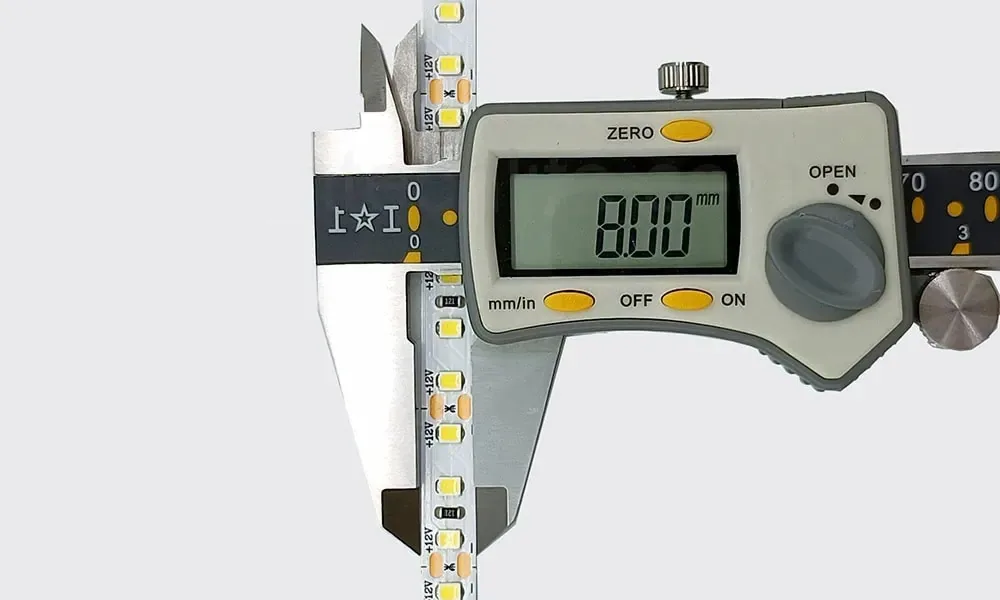
Taśmy świetlne LED 10mm: 10 mm paski LED są zazwyczaj używane w ogólnych projektach oświetleniowych. Oferują wysoką jasność i są powszechnie używane w oświetleniu architektonicznym, oświetleniu wnękowym i dekoracyjnych oprawach oświetleniowych do zastosowań mieszkaniowych i komercyjnych. Ponadto, niezależnie od tego, czy chodzi o oświetlenie akcentujące w domach, czy oświetlenie funkcjonalne w sklepach detalicznych, paski LED 10 mm można łatwo dostosować do różnych środowisk użytkowania. Ta wszechstronność obejmuje również opcje kolorystyczne, przy czym wiele pasków LED 10 mm oferuje wersje RGB i regulowane białe światło, co pozwala użytkownikom dostosować oświetlenie zgodnie z ich preferencjami.
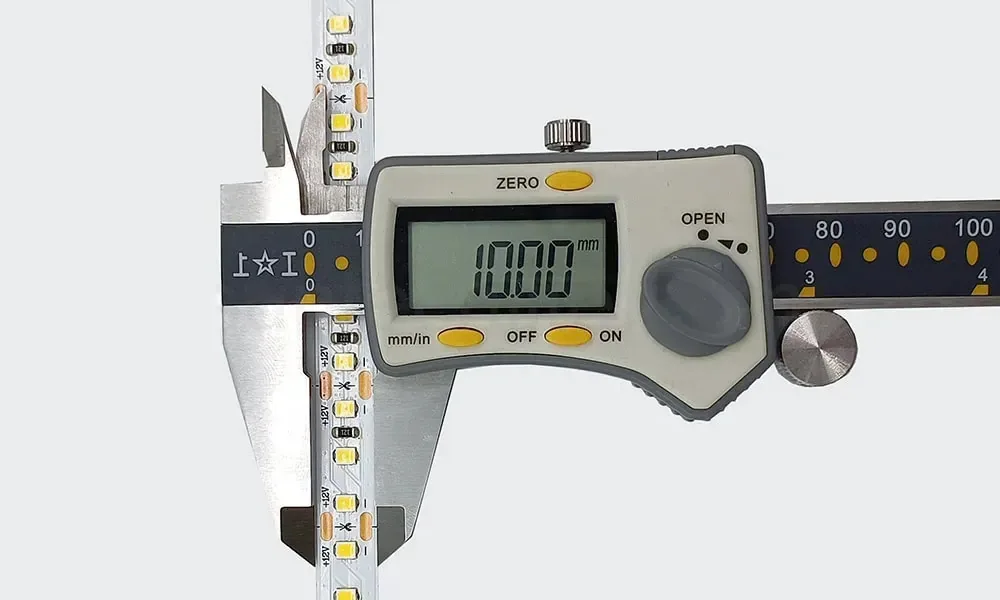
Taśmy świetlne LED 12mm: 12 mm paski świetlne LED są nieco szersze i zazwyczaj oferują większą moc światła. Są powszechnie używane w zastosowaniach wymagających jaśniejszych, mocniejszych rozwiązań oświetleniowych, takich jak oświetlenie zewnętrzne lub instalacje na większą skalę. Ta szerokość umożliwia większą gęstość diod LED, jasność i równomierny rozkład światła. 12 mm paski świetlne LED są idealne do oświetlenia architektonicznego, przede wszystkim dlatego, że w oświetleniu architektonicznym połączenie estetyki i funkcjonalności ma kluczowe znaczenie dla podkreślenia kluczowych cech i tworzenia punktów zainteresowania.
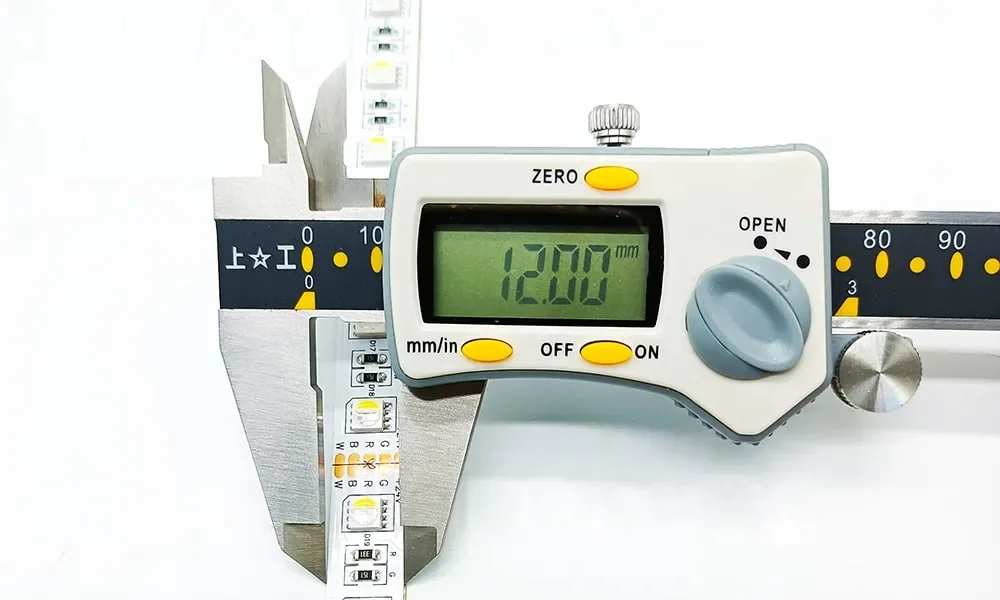
Taśmy świetlne LED o szerokości 15 mm i szersze: 15 mm i szersze paski LED mają większą gęstość i jasność LED. Nadają się do oświetlenia komercyjnego i instalacji na dużą skalę. Paski te zapewniają równomierne oświetlenie z minimalnymi cieniami, dzięki czemu idealnie nadają się do projektów architektonicznych i oznakowań. Szersze paski mogą pomieścić więcej diod LED i pomagają w lepszym odprowadzaniu ciepła, co jest kluczowe dla zapobiegania przegrzaniu podczas długotrwałego użytkowania. Dlatego są wystarczające do profesjonalnych zastosowań, w których spójność wydajności i niezawodność mają kluczowe znaczenie.
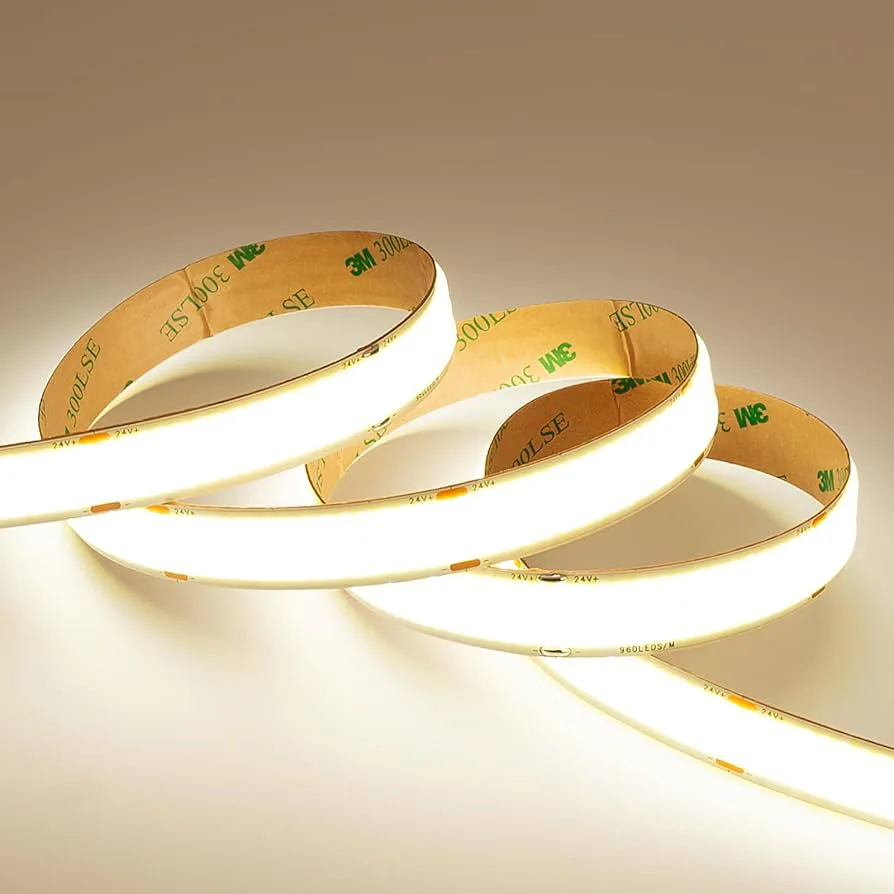
Taśma świetlna LED COB o szerokości 15 mm, ultra jasna, bez kropek
Model: FYX15T1920C
Ilość chipów LED na metr: 1920 żetonów
Wskaźnik oddawania barw: >90
Szerokość PCB: 15mm
Temperatura barwowa: 3000K/4000K/6000K
Napięcie wejściowe: Prąd stały 24 V
Moc na metr: 25 W
Długość możliwa do przecięcia: 20,67 mm
Wersja wodoodporna: IP20/IP65
Gwarancja: 3 lata
Ultrawąskie paski świetlne LED: Taśmy świetlne LED o szerokości 3 mm, 4 mm i 5 mm są zazwyczaj określane jako ultrawąskie taśmy świetlne LED, co czyni je idealnymi do ultracienkich i dyskretnych potrzeb oświetleniowych. Ich kompaktowy rozmiar umożliwia łatwą instalację w wąskich przestrzeniach, takich jak krawędzie szafek, gabloty i konstrukcje architektoniczne. Te taśmy świetlne są idealne do minimalistycznych projektów, w których źródło światła jest ukryte, a jednocześnie zapewnia czyste i eleganckie oświetlenie.
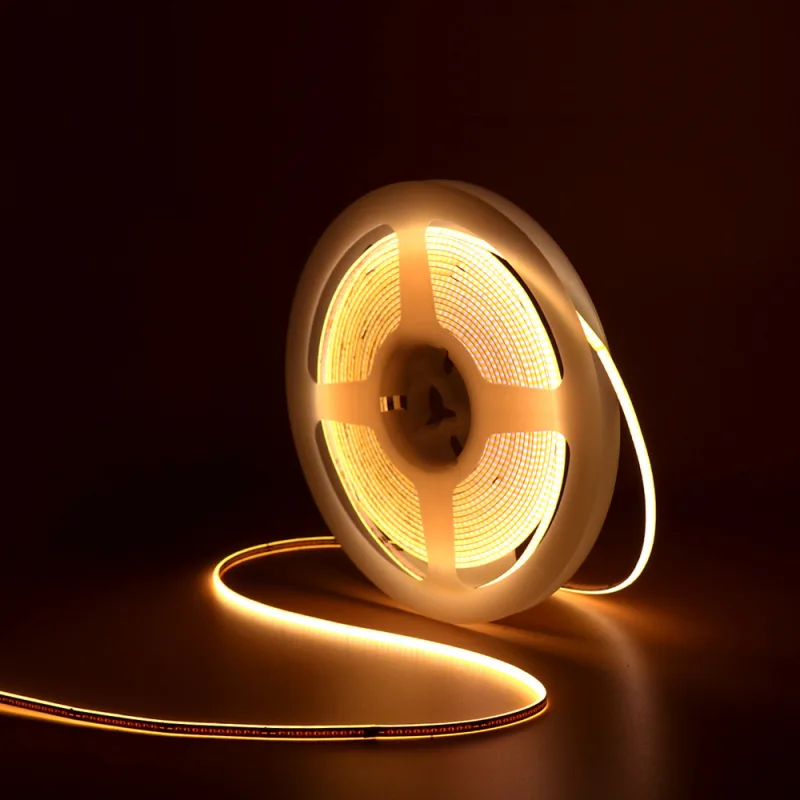
Ultrawąska taśma świetlna COB LED
Model główny: FYX04T400C
Ilość diod LED na metr: 400 żetonów (Sanan)
Opcja szerokości PCB: 3mm/4mm/5mm
Opcje kolorystyczne: 2700K/3000K/4000K/6000K
Wskaźnik oddawania barw: >90
Napięcie wejściowe: Prąd stały 5 V/prąd stały 12 V/prąd stały 24 V
Moc na metr: 5,5 W/10 W
Efektywność: 90–110 lumenów/wat
Opcja stopnia IP: Stopień ochrony IP20/IP54/IP65/IP67/IP68
Gwarancja: 3 lata

Wiele osób zadaje sobie to samo pytanie: Czy wszystkie paski świetlne LED mają taką samą szerokość? Odpowiedź brzmi: nie. Aby sprostać różnym wymaganiom aplikacji, nie wszystkie paski świetlne LED mają taką samą szerokość PCB. W wąskich przestrzeniach instalacyjnych, takich jak wnętrza szafek, szersze paski świetlne LED są trudne do ukrycia ze względu na ograniczoną przestrzeń. Jeśli chcesz dodać oświetlenie LED w wąskich szczelinach, możesz użyć węższych pasków świetlnych LED. W związku z tym projekt szerokości pasków świetlnych LED często spełnia zróżnicowane potrzeby użytkowników.
Czy zatem szerokość pasków świetlnych LED jest ważna? W rzeczywistości w przypadku przestronnych obszarów instalacji szerokość pasków świetlnych LED nie jest krytyczna. Zamiast tego gęstość i jasność pasków świetlnych LED są ważniejsze, ponieważ przestronne obszary zazwyczaj wymagają większej jasności, aby oświetlić szczegóły. Szerokość pasków świetlnych LED jest krytyczna tylko w przestrzeniach z ograniczeniami szerokości.
Podsumowując, każda szerokość paska świetlnego LED oferuje unikalne zalety dla różnych zastosowań, zapewniając, że Twój projekt oświetleniowy łączy funkcjonalność i estetykę. Poniżej znajduje się kilka szerokości paska świetlnego LED w celach informacyjnych.
| Itematy | Taśma LED 2835 Szerokość | 5050 Taśma LED Szerokość | KACZAN Taśma LED Szerokość |
| Pojedynczy rząd | 5 mm, 6 mm, 8 mm, 10 mm, 12 mm | 10mm, 12mm, 14mm, 15mm | 3 mm, 4 mm, 5 mm, 8 mm, 10 mm, 12 mm |
| Podwójny rząd | 15mm, 20mm | 15mm | 12mm |
| Potrójny rząd | 16mm, 22mm, 32mm | 32mm, 58mm | 12mm, 20mm |
| Czterorzędowy rząd | 28mm, 30mm | Brak | 15mm, 20mm |
| Pięć rzędów | 64mm | 58mm | 30mm |
| Osiem rzędów | Brak | 120 mm | Brak |
Czy wysokość taśm LED ma wpływ na montaż?
Wybierając paski świetlne LED do różnych zastosowań, oprócz szerokości, wysokość ma również kluczowe znaczenie. Grubsze paski świetlne mogą nie pasować do kompaktowych projektów lub wąskich przestrzeni, co ogranicza ich zastosowanie w instalacjach wpuszczanych lub montowanych na powierzchni. Ultracienkie paski świetlne LED są idealnym wyborem do eleganckich, stonowanych projektów, ponieważ można je łatwo zainstalować w wąskich lub płytkich przestrzeniach, co ułatwia instalację.
IP20 (nie wodoodporny): Wysokość około 1,5 milimetra. Te paski świetlne LED są wyjątkowo cienkie ze względu na brak wodoodporności. Są dobrze przystosowane do montażu w suchych miejscach wewnątrz pomieszczeń, takich jak pod szafkami lub jako oświetlenie akcentujące.

IP65 (powłoka silikonowa): Wysokość 2-3 milimetry. Te paski świetlne są pokryte warstwą silikonu, co zapewnia pewną wodoodporność. Dlatego są idealne do kuchni, łazienek lub innych miejsc, które mogą być lekko wilgotne.
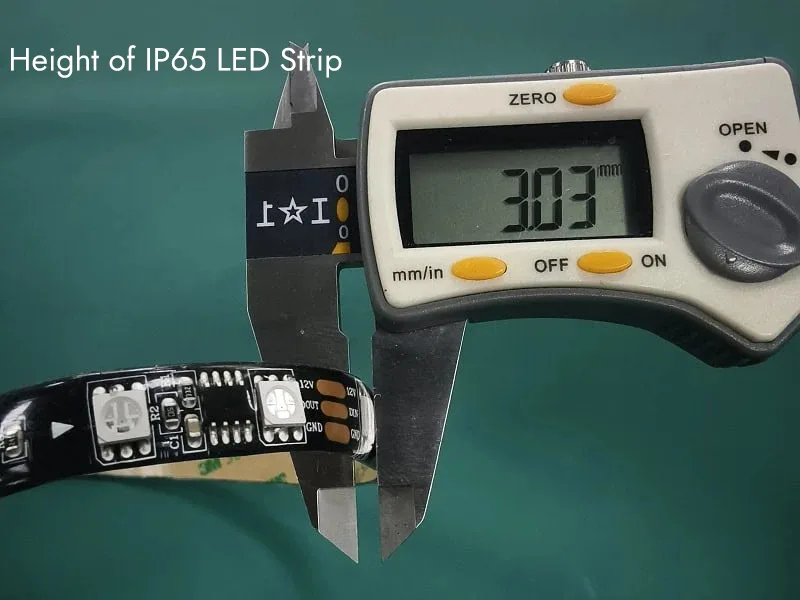
IP68 (zalewanie rurką silikonową): Wysokość: 5-8 milimetrów. Paski świetlne LED IP68 są w pełni zatopione w trwałym silikonie lub żywicy epoksydowej. Paski świetlne LED IP68 są idealne do zastosowań zewnętrznych i podwodnych, w tym fontann i oświetlenia krajobrazowego.
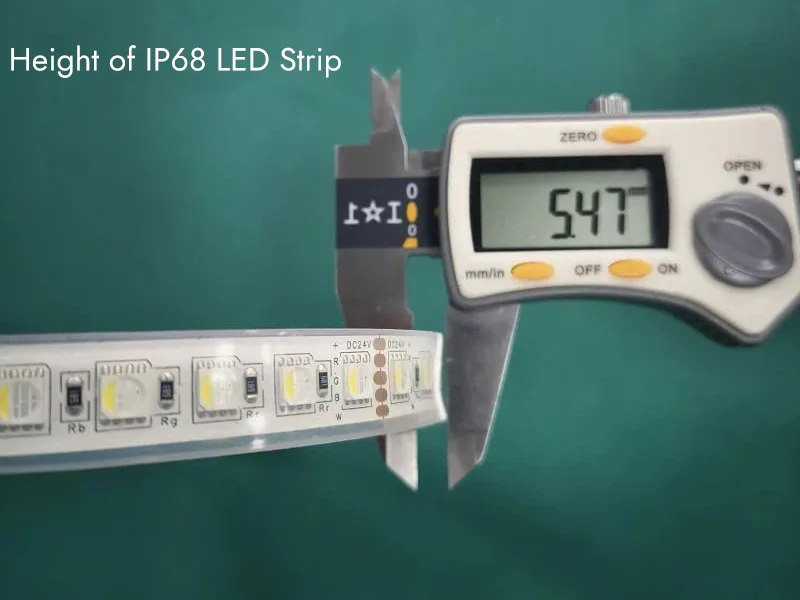
Aby uzyskać więcej informacji na temat wodoodpornych pasków świetlnych LED, przeczytaj „Przewodnik po wodoodporności pasków świetlnych LED." I "6 kroków do wyboru wodoodpornych pasków świetlnych LED do użytku na zewnątrz.”
Jak wybrać odpowiednią szerokość taśmy LED do swojego projektu?
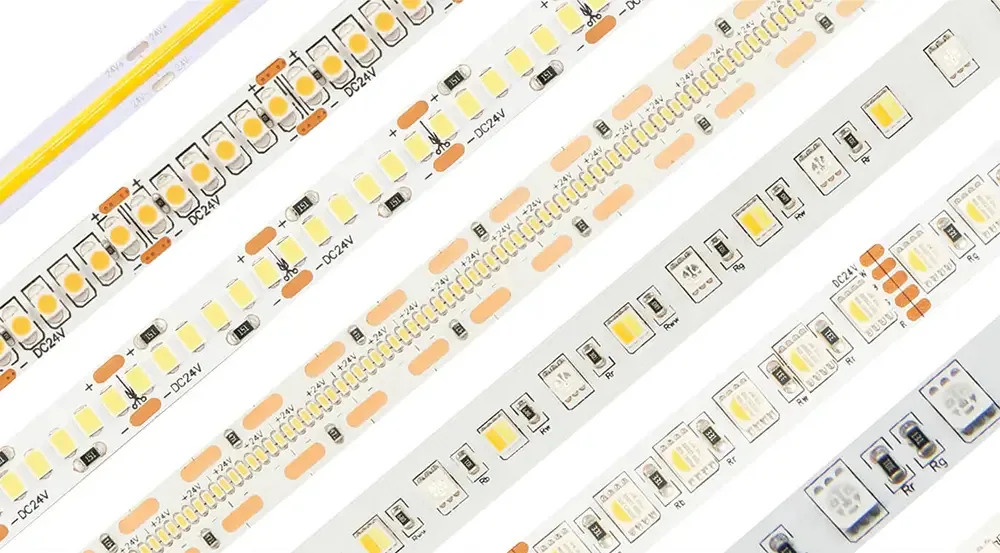
Wybór odpowiedniej szerokości paska świetlnego LED zapewnia, że Twój projekt oświetleniowy jest zarówno praktyczny, jak i estetyczny. Dlatego wybierając szerokość paska świetlnego LED, weź pod uwagę ograniczenia przestrzenne, wymaganą jasność i zamierzone zastosowanie. Wąskie paski są idealne do ciasnych przestrzeni, podczas gdy szersze paski oferują większą jasność i są idealne do większych powierzchni. Dlatego dokładnie rozważ następujące zalecenia:
1. Zrozum wymagania swojego projektu: Przed wyborem szerokości paska świetlnego LED oceń konkretne potrzeby swojego projektu. Określ miejsce instalacji paska świetlnego LED. Czy potrzebujesz 5-milimetrowego ultrawąskiego paska świetlnego LED do wąskich szczelin, czy jaśniejszego 20-milimetrowego paska świetlnego LED do większych powierzchni?
2. Ograniczenia przestrzenne: Dostępność przestrzeni odgrywa kluczową rolę w określeniu odpowiedniej szerokości. W przypadku małych przestrzeni, takich jak wnętrza szafek lub pod półkami, wybierz węższe szerokości, takie jak 8 mm lub 10 mm. Te smukłe profile płynnie wtapiają się w ciasne przestrzenie, nie sprawiając wrażenia masywnych.
3. Wymagany poziom jasności:Poziom jasności wymagany dla projektu również wpływa na Twoją decyzję. Szersze paski, takie jak 15 mm i 20 mm, mogą pomieścić więcej diod LED na jednostkę długości, zapewniając większą jasność. Są idealne do obszarów wymagających dużego oświetlenia, takich jak kuchnie lub miejsca pracy.
4. Wymagania dotyczące konkretnej aplikacji: Rozważ konkretne zastosowanie paska świetlnego LED. Na przykład, jeśli planujesz zapewnić oświetlenie otoczenia w środowisku mieszkalnym, pasek świetlny o szerokości 10 milimetrów może być wystarczający. Jednak w zastosowaniach komercyjnych wymagających stabilnego oświetlenia szersze paski świetlne mogą być bardziej odpowiednie.
5. Zagadnienia instalacyjne: Nie należy pomijać wymagań instalacyjnych (np. zasilania i opcji instalacji). Niektóre szersze paski świetlne, ze względu na większe zużycie energii, mogą wymagać dodatkowych rozwiązań sprzętowych lub energetycznych.
Podsumowując, wybór odpowiedniej szerokości paska świetlnego LED wymaga zrównoważenia przestrzeni fizycznej, wymaganej mocy światła i rzeczywistych czynników instalacji. Oceniając te aspekty, możesz upewnić się, że Twój wybór jest zgodny z funkcjonalnymi i estetycznymi celami projektu.
Czy szersze paski świetlne LED zużywają więcej prądu?
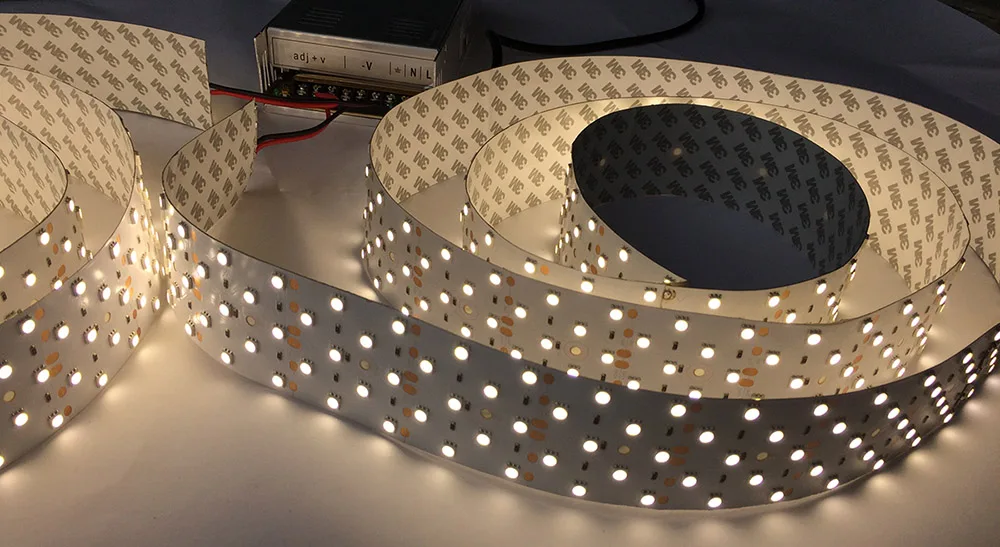
Szersze paski świetlne LED niekoniecznie zużywają więcej prądu. Zależy to od gęstości LED, rozmiaru chipa, jakości i zasilania. Główne powody są następujące:
- Typ układu LED:Rodzaj i jakość chipów LED używanych w paskach świetlnych mają znaczący wpływ na zużycie energii. Przy tej samej jasności, bardziej wydajne i zaawansowane chipy LED zużywają mniej energii.
- Gęstość diod LED:Liczba diod LED na jednostkę długości wpływa na zużycie energii. Większa gęstość diod LED oznacza zazwyczaj więcej diod LED, co skutkuje większym zużyciem energii.
- Moc znamionowa:Moc znamionowa paska świetlnego LED jest mierzona w watach na metr (W/m), co wskazuje ilość energii elektrycznej zużywanej na metr paska świetlnego LED. Wyższa moc znamionowa zwykle oznacza większe zużycie energii.
- Operacyjny Woltaża:Napięcie robocze pasków LED również wpływa na zużycie energii. Paski LED zazwyczaj oferują różne opcje napięcia, takie jak 12 V DC lub 24 V DC. Paski o wyższym napięciu często wymagają niższego prądu, co potencjalnie czyni je bardziej energooszczędnymi.
Dokładniej rzecz biorąc, większe chipy LED zużywają więcej energii. Na przykład pasek LED SMD5050 o szerokości 10 mm zużywa więcej energii niż pasek LED SMD2835 o tej samej szerokości. Podobnie, jeśli dwa paski LED SMD2835 mają tę samą gęstość, ale jeden ma szerokość 5 mm, a drugi 10 mm, nie oznacza to koniecznie, że szerszy zużywa więcej energii. W tym przypadku szerokość paska LED nie ma bezpośredniego związku z poborem energii.
Aby uzyskać więcej informacji na temat pasków LED SMD2835 i SMD5050, przeczytaj „SMD3528 vs SMD2835 vs SMD5050: Która taśma LED jest najlepsza do oświetlenia komercyjnego i architektonicznego?.”
Jednak, jak wspomniałem wcześniej, paski LED z większymi chipami zużywają więcej energii niż te z mniejszymi chipami. Ale różnica jest minimalna. Na przykład dla pasków LED 2835 i 5050 o gęstości 60 diod LED na metr, pobór mocy jest następujący:
| Układ LED | Moc na chip | Moc na metr (60Diody LED/m Pasek LED) |
| SMD2835 | 0,2 W | 12W |
| SMD5050 | 0.24W | 14,4 W |
Jak pokazano w tabeli porównawczej powyżej, średnia różnica mocy na metr taśmy LED wynosi nieco ponad 2 waty. Chociaż ma to wpływ na zużycie energii, nie ma to znaczącego wpływu na długoterminowe kalkulacje kosztów.
Ponadto im większa gęstość paska LED, tym więcej chipów LED wymaga zasilania, co skutkuje większym zużyciem energii. Innymi słowy, pasek LED o szerokości 10 mm z 60 diodami LED na metr zużywa więcej energii niż pasek LED o szerokości 10 mm z 30 diodami LED na metr.
Dlatego też, chociaż szersze paski świetlne LED mogą mieć więcej diod LED i potencjalnie wyższe zużycie energii, nie zawsze tak jest. Należy wziąć pod uwagę kluczowe czynniki wymienione powyżej. Dlatego należy sprawdzić specyfikacje produktu i wybrać paski świetlne LED, które spełniają wymagane standardy jasności i efektywności energetycznej.
Wniosek
Wybór odpowiedniej szerokości paska LED ma kluczowe znaczenie dla powodzenia projektu. Dokonując wyboru, dokładnie rozważ przestrzeń, jasność i wymagania dotyczące zastosowania. Każda szerokość oferuje różne funkcjonalności, od delikatnego oświetlenia akcentującego po intensywne oświetlenie dużych powierzchni. W każdym projekcie wymagania estetyczne lub funkcjonalne zależą od właściwego wyboru szerokości paska LED: od kompaktowych 8 mm do szerszych szerokości, zawsze istnieje rozwiązanie, które spełni wszystkie Twoje potrzeby.
Niezależnie od szerokości pasków LED, których potrzebujesz do swojego projektu oświetlenia, SignliteLED jest najlepszym rozwiązaniem. Oferujemy szeroką gamę Taśmy świetlne SMD LED I Taśmy świetlne COB LED aby spełnić Twoje potrzeby. Ponadto oferujemy usługi dostosowywania, OEM i ODM. Skontaktuj się z nami już dziś, aby uzyskać potrzebną szerokość paska LED!
